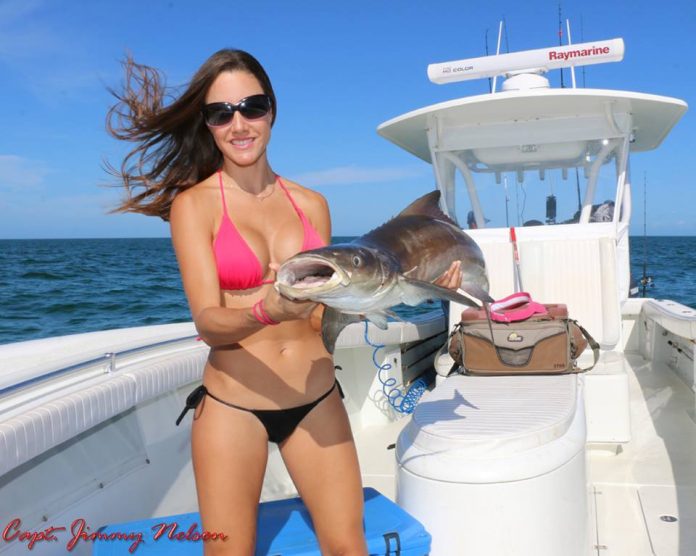Warmer and calmer weather patterns were the trend in the Tampa Bay region over the past week, and some traditional warm water trends seemed to settle in at the Sunshine Skyway Fishing Piers. Tarpon are around in great numbers, and visitors are enjoying watching these majestic fish roll all around the piers. Spanish mackerel have been taken in reliable numbers late in the day on both live and cut baits. Mangrove snapper continue on a great bite, and many large grunts are joining the snapper in filling coolers for a family fish fry. Bluefish and ladyfish have been biting after dark at a good pace, providing both eating & bait options for overnight anglers. Finally, shark action is set at a high pace, and many visitors are having a great time fighting sharks of various sizes and species.
Spanish mackerel seemed to prefer live or freshly cut baits over the past week. Some fish are taking artificial lures near the surface as well. Live and cut baits were fished on long shank hooks & fluorocarbon leader with either a split-shot sinker or float – depending upon where fish were in the water column. Many fish seemed to be striking up high this past week, so either free-lining baits or floats kept natural baits in the strike zone. This scenario also lends itself to topwater artificial lure presentations like spoons or tube (straw) lures fished behind a popping cork. One method catching on with artificial lure anglers is using a water-filled float pegged above a white striper popping fly. This method is often used for schooling stripers in the northeast, but it has been taking mackerel in good numbers for several seasoned pier visitors over that past few seasons.
Bluefish and ladyfish are providing great sundown options for many anglers visiting the Skyway Piers. These species are always aggressive, but both seem even more energized after darkness falls. Topwater plugs might be the most fun way to procure a fine multi-species catch, but many other artificial lure and natural bait methods work on these fish. Fishing cut strip baits with a cork or split-shot sinker can work well, but so can bottom fishing with a traditional bait rig. Some anglers cherish these species as cut or live bait for shark or tarpon fishing, but others realize that both can be fine table fare if prepared properly. The best table results can be obtained by bleeding both promptly in a bucket of water. Bluefish can then be filleted or chunked for a fine fish chowder ingredient, while ladyfish can be filleted, briefly frozen and finally separated from the bones for use in succulent fish patties.
Tarpon action is heating up on both fishing piers, not only during the evening crab flushes, but also during mid-day tide changes. The night bite on tarpon during hill tide crab flushes at the Skyway Piers is nothing short of outstanding. Fish can be heard engulfing pass crabs in the darkness at the same time anglers are free-lining out their crab offerings. Sharp-dropping outgoing tides after sunset are best for crab drifts, but some tarpon remain around the piers no matter the tidal cycle. To connect with fish that seem to have taken up residence, look to cast a large live shrimp or sardine so that it drifts just past the tarpon’s strike zone. Daylight anglers have it even easier to almost ensure a bite from the silver king. A large free-lined pinfish or pigfish swimming with the tide just after a tide cycle change will get tarpon takes at almost every opportunity. Use heavy conventional gear and bring a camera or smartphone – you can take a nice picture from above just before releasing your catch.
The blue crab flush remains strong on evening hill tides – especially at the North Pier. Long-handled nets, spotlights and headlamps are the name of the game. The North Pier gets the highest number of crabs and thus the highest number of visitors. The South Pier can also produce some drifting blue crabs on the same tides. While visitors cannot expect the number of crabs seen on the North Pier at the South, there is much more room for parking, searching and fishing. Some families will choose less crabs if it means a more relaxed environment where family fishing & crabbing are enjoyed at the same time.
- The Skyway, Paul Bristow - August 24, 2018
- The Skyway, Paul Bristow - August 17, 2018
- The Skyway, Paul Bristow - August 10, 2018










